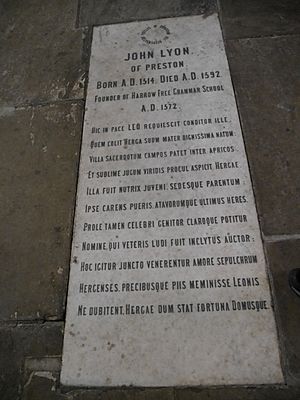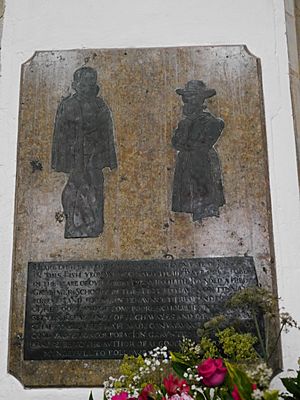John Lyon (school founder) facts for kids
Quick facts for kids
John Lyon
|
|
|---|---|
| Born | 1514 |
| Died | 1592 |
| Resting place | St Mary's, Harrow on the Hill |
| Nationality | English |
| Occupation | Charitable landowner |
| Known for |
|
| Relatives |
|


John Lyon (1514–1592) was an important English landowner. He owned a lot of land in the area of Harrow. He is best known for starting Harrow School and The John Lyon School. He also created the John Lyon's Charity, which still helps people today. One of the houses at Harrow School is named Lyon's after him. He was part of the Anglo-Norman Lyons family. His first cousin, Sir John Lyon, was the Lord Mayor of London from 1554 to 1555.
Contents
John Lyon's Life
John Lyon was born in 1514 and lived at Preston Hall. His family, the Anglo-Norman Lyons, owned land in Harrow-on-the-Hill. His father was also named John Lyon. His cousin, Sir John Lyon, was a very important person who became the Lord Mayor of London.
John Lyon passed away on October 3, 1592. He did not have any children. His wife, Joan, died later in 1608. Both John and Joan were buried at St Mary's, Harrow on the Hill. You can find memorials to them there. There is a special brass plaque with their images and a Latin message on it.
Founding Schools and Charity
By 1564, John Lyon had the most land and earned the most money from renting out land in Harrow. In 1572, he founded Harrow School. He also started The John Lyon School and the John Lyon's Charity. These were all created with a special permission called a Royal Charter.
The John Lyon's Charity
John Lyon set up a special fund, or trust, to help keep roads in good condition. This included Harrow Road and Edgware Road. Today, the money from his original land is managed by John Lyon's Charity. This charity gives money to other charities and to public schools. They help young people in nine areas of London. These areas include Barnet, Brent, Camden, Ealing, Hammersmith & Fulham, Kensington & Chelsea, Harrow, and the Cities of London and Westminster.
The Lyon family's coat of arms (a special family symbol) had a lion on it. This lion symbol can still be seen today. It is part of the coat of arms of the London Borough of Brent and the coat of arms of the London Borough of Harrow.
Starting Harrow School
John Lyon spent money each year to help educate poor children. Because of his efforts, on February 13, 1572, Queen Elizabeth I gave him a Royal Charter. This allowed him to start a free grammar school for boys in Harrow. This meant boys could get an education without paying fees. The charter also made his trustees (people who managed his money) the Governors of the "Free Grammar-School of John Lyon."
He also bought property in Marylebone in 1571. The money earned from these properties was used to fix the main road between Edgware and London. Any extra money was used to fix the road between Harrow and London. John Lyon wanted to make sure his school's money was safe. He even had to protect his funds when the government wanted to borrow money from him.
In 1590, John Lyon wrote down the rules for his school. These rules said that the head teacher should have a university degree. There should also be an assistant teacher. Both teachers had to be unmarried. The rules also covered what students would learn. They learned the Protestant catechism and went to church. Older students also learned Greek. The rules even mentioned activities for the students, like playing handball and shooting.
See also

